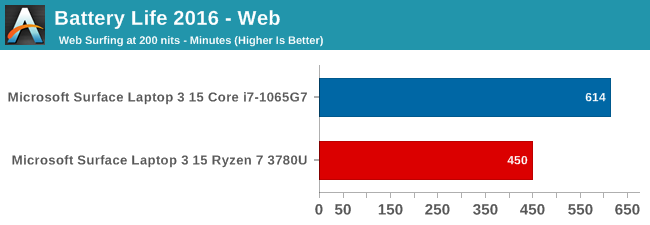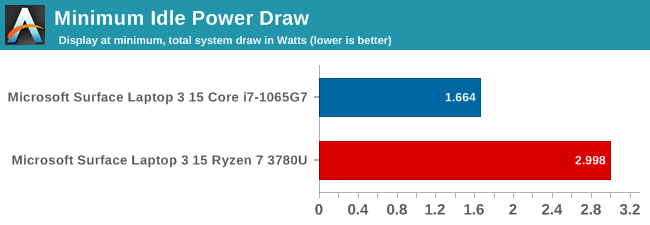The Microsoft Surface Laptop 3 Showdown: AMD's Ryzen Picasso vs. Intel's Ice Lake
by Brett Howse & Andrei Frumusanu on December 13, 2019 8:30 AM ESTPlatform Power
Performance aside, the other side of the coin is battery life. AMD made big gains in battery life with the Ryzen 3000 series, somewhat addressing the power requirements of the platform and getting rid of some of the excessive idle power draw, but they are still using DDR4 on their mobile platform, which puts them at a disadvantage right out of the gate. Intel has made very good gains in battery life over the last several generations, and the move to 10 nm for Ice Lake also brought along LPDDR4X support. Most of the previous generation laptops stuck with LPDDR3, unless the manufacturer needed more than 16 GB of RAM, where they’d be forced to switch to DDR4. Finally adding LPDDR4X support is something that Intel has needed to do for a while, and ironically Intel’s flagship Core product line lagged behind their low-cost Atom lineup which did support LPDDR4.
Web Battery Life

The Ryzen 7 3780U powered Surface Laptop 3 was slightly under the Ryzen 5 device we tested at launch, but still in the same range. The AMD system isn’t helped very much by Microsoft only offering a 46 Wh nominal battery capacity, which is rather undersized for a 15-inch laptop. The Ice Lake device, as we’ve seen before, was much more efficient under load, offering a sizeable battery life lead.
Idle Power
One of AMD’s biggest challenges was to get their laptop SoC into a premium device, and with the Surface Laptop 3 they have succeeded. Microsoft has shown themselves as being adept at squeezing battery life out of devices, with low-power displays, and good internal components to minimize power draw. Here Intel has held a considerable advantage over the last couple of years, and the move to 10 nm should, in theory, help as well.
To test the idle power draw of both systems, the battery discharge rate was monitored with the screens fixed in at 5.35 nits, to minimize the power draw of the display on the result. Normally we’d prefer to have the display completely off for this test, but Microsoft’s power plan on the Surface Laptop actively turns off the laptop when the display times out.

The Ice Lake system was able to go all the way down to right around 2 Watts of power draw – and sometimes slightly under – with as low as 1.7 Watts seen. We’ve seen under 1 Watt of draw on an 8th generation Core Y series processor, and around 1.5 Watts on the same generation U series, so considering the display is not completely off on the Surface Laptop, the 2-Watt draw is quite reasonable.
The Picasso system was not quite as efficient, drawing 3 Watts at idle. This is in-line with the results we’ve seen on other Picasso systems and explains the lower battery life results on the AMD system. AMD made big gains moving from Raven Ridge to Picasso, but I’m sure the team is looking forward to the 7 nm Zen 2 coming to their laptops, which we hope will address this further.










174 Comments
View All Comments
Fataliity - Saturday, December 14, 2019 - link
That came out wrong re-reading it. sorry its late. AMD's die is twice the size which should let it cool better. and apu ccx is 60mm squared, intel's for 4 cores is almost the same on ice lake. So yes a similar power for similar heat would make sense. We don't know what's coolin the inside on both of these either though, that could make a big difference. However, I still think it's questionable when Intel boosts and hits 100 degrees C, just looks like they're pushing the CPU as far as possible to make it look as good as it can, knowing the new APU's are coming out soon.And yes, the fact that it can draw 42 watts on CPU at boost definitely seems like an unfair advantage. The temps also reflect that in 25 seconds it overheats due to it too, forcing to ramp down.
Fataliity - Saturday, December 14, 2019 - link
And I looked into the IO. It should pull 10-15W, including graphics idle, putting Ryzen on par with Ice Lake around 20-25 watts. Which would make more sense.pifaa - Saturday, December 14, 2019 - link
Personal opinion. The review is very obviously biased towards Intel. The tests are carefully sellected to demonstrate Intel dominance, which in the real world is non present anymore. The only advantage Intel still has over AMD in the mobile space, is power consumption. As we see, that advantage is shrinking fast.m53 - Saturday, December 14, 2019 - link
Personal opinion. The earth is flat.GruenSein - Saturday, December 14, 2019 - link
The results are no surprise. It’s Intel‘s newest architecture and manufacturing node against AMD‘s year old Zen1+ on 12nm. It’s too bad that AMD take their time updating mobile parts and APUs. A Zen2 + Navi on 7nm should be much more competitive. This is the inverse situation we see in desktop parts where there is no sunny cove and still 14nm for Intelyeeeeman - Saturday, December 14, 2019 - link
Lets see what AMD brings to the table with zen 2. Intel does have a better ipc with ice lake, even compared to zen 2, but it has a handicap in the fact that it is built on 10nm and they have only 4 cores in 15w tdp. I am pretty confident that AMD can afford a 6 core in the same tdp, like comet lake.dragosmp - Saturday, December 14, 2019 - link
The boost behavior is very erratic on the AMD. I assume this ramping up/down under load is quite inefficient and buts a high emphasis on how fast the CPU can ramp up and down.Looks very erratic to the point of being defective. Multi-core loads though are fine. Does this mean when a low-threaded task is ran the scheduler bunny hops the task on all cores? This used to be a problem on Ryzen1 and thought it was solved with an AMD driver, but it came back maybe on this MS product.
I suspect a few % performance were left on the table, but like most here I assume the GPU is bandwidth-starved and high speed memory can't come soon enough for AMD. Quite surprising how poor they are with feeding the GPU, lack of dev on the GPU side in the last few years has hurt a lot.
AshlayW - Saturday, December 14, 2019 - link
Awesome result for the Ice Lake chip. But let's keep expectations in check here; the Ryzen part is based on a uArch from 2017 with slight optimisations, and also has half the L3 cache size due to a significant process disadvantage. While a very valid product v product comparison it is not particularly 'fair' as Intel's development (sunk) costs for the ICL and 10nm node are astronomically higher than Picasso's.I consider this 'flavour' until AMD can finally pull its finger out of its rear and get Zen2 mobile cores on 7nm, which should match or beat this. Finally, the memory limitation on the Picasso part is severely holding it back. I have no idea they wouldn't have opted for DDR4-2933 (what Picasso supports natively), which can lower its clock rate in less demanding tasks for higher efficiency. In some of these tests, this could have allowed AMD the win (which would have been particularly impressive given the huge aforementioned uArch/Node advantages Intel has). The bandwidth would have especially helped in the graphics tests. If the AMD surface design is significantly cheaper (I am willing to bet AMD can give these chips for 25% of what Intel is selling the ICL for) it could slot nicely in as a lower performing, but also much lower cost alternative.
I will wait patiently for Renoir to see what 7nm Zen2 can do in mobile; arguablly where it is most needed.
scineram - Monday, December 16, 2019 - link
I think they worried about power with faster memory.MBarton - Monday, December 30, 2019 - link
profit margin limited and not enough leftover Zen 2 after satisfying Epyc orders, THR3/Ryzen 3k, and console orders.